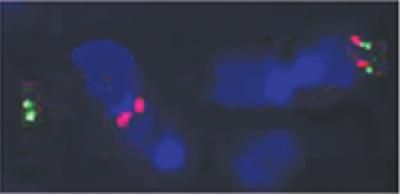New ways for controlled drug activation
A completely new approach - Ultrasound for drug activation
Advertisement
Researchers at the DWI - Leibniz Institute for Interactive Materials have succeeded in developing a completely new system for activating pharmaceutical agents. The unique feature: Their method is based on the use of ultrasonic waves. The drugs are enclosed in carrier molecules. The ultrasound waves and the associated mechanical forces induce chemical bond scission of the carrier molecules, so that the active ingredients are released and switched on. "Among others, we have tested our method on conventional antibiotics and an anticancer drug. The release and subsequent activation of the respective active ingredients open up completely new possibilities for us to control drug action", explains Prof. Dr. Andreas Herrmann, vice scientific director of the institute and Chair of Macromolecular Materials and Systems (RWTH Aachen University). He is one of the leading scientists of the project. The research team is presenting three novel approaches that differ in the type and structure of the carrier elements as well as their binding strengths and properties: A chemical, a bio-inorganic, and a biochemical approach. In this way, covalent and non-covalent bonds of the carrier molecules can be broken specifically and as required, so that the release of the active ingredients can be controlled and dosed over time.
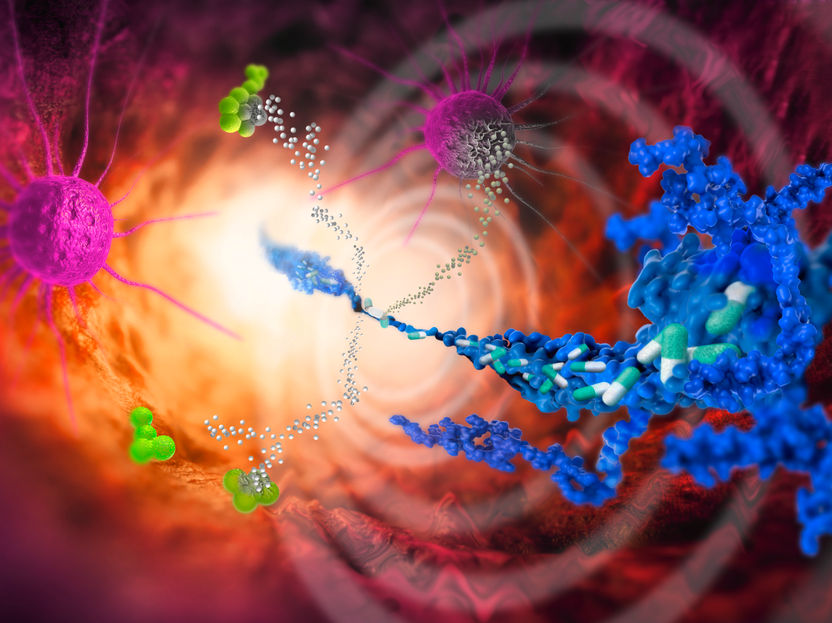
Ultrasound can be used to selectively activate drugs (white and gray) from carrier molecules (blue). Prof. Andreas Herrmann and Dr. Robert Göstl from the DWI - Leibniz Institute for Interactive Materials (Aachen) have thus developed a mechanism that represents the first step on the way to alternative drug release to combat cancer cells (pink) or bacteria such as Staphylococcus aureus (light green).
DWI – Leibniz-Institut für Interaktive Materialien, grafische Erarbeitung: walbert visuelle Kommunikation
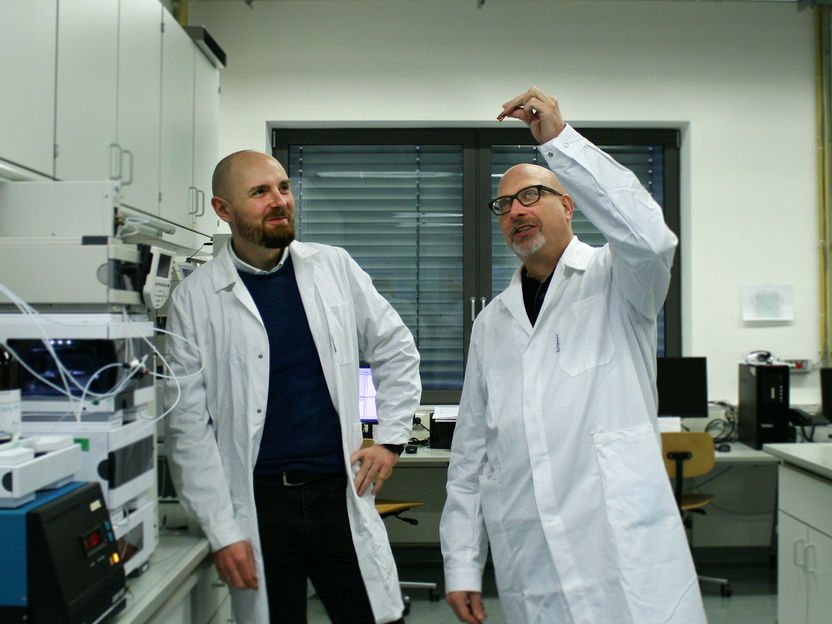
Does the sample have the desired quality? Prof. Andreas Herrmann (right) and Dr. Robert Göstl (left) look at a purified sample and decide how to proceed with the experiments.
DWI – Leibniz-Institut für Interaktive Materialien, Silke Rieder
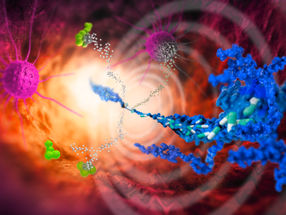
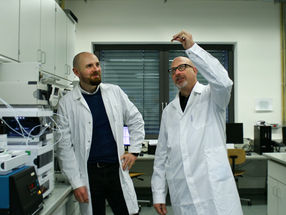
Dose too high and not in the right place: weaknesses of current drug therapies
Treating patients with drugs is one of the most important and frequently used medical therapies currently available. However, the systemic use of drugs is a trade-off between desirable treatment and side effects. The associated disadvantages must be accepted due to the prevailing lack of drug selectivity, i.e., the ability of active ingredients to achieve only the desired effect at a specific site inside the body. Apart from antibiotics, this affects drugs against cancer in particular. Although their largely aggressive effect is intended for tumor tissue, the active ingredients can also damage healthy cells and tissues due to the lack of controllability in selectivity and local dosage. The extent of damage can eventually lead to the killing of cells and tissues.
In addition to severe side effects, the systemic or excessive use of antibiotics inevitably leads to the emergence of antimicrobial resistance. Scientists warn that multidrug-resistant pathogens could endanger the lives of millions of people as early as 2050. It is therefore essential that this type of treatment is designed to be as precise and controllable as possible to achieve a targeted delivery of the active ingredients "at the point of action" inside the body.
Sonopharmacology - a modular principle for different challenges
With the unprecedented approach presented here, the team has designed a blueprint for pharmacotherapy: systemic side effects can be avoided. Moreover, therapies can be tailored to medical requirements and clinically established drug release techniques with spatiotemporal resolution. Therefore, these approaches could be the starting point for a new field called "sonopharmacology". This would be analogous to the field of photopharmacology, which has recently been established: an emerging approach in medicine for the light-induced drug activation. In addition to optimization processes and adjustments of the systems, the scientists have already begun to take a further step: "Based on our previous work we are in the process of developing a modular principle. Our goal is to make it possible for anyone to design their own carrier molecules for other drugs, such as those for blood clotting," states Dr. Robert Göstl, who played a key role in the scientific work. He is head of an independent research group at the DWI and habilitant at the RWTH Aachen University. The project was implemented by combining the respective expertise of Andreas Herrmann and Robert Göstl: Among other things, Andreas Herrmann investigates alternative release systems for active ingredients, while Robert Göstl conducts research in the field of mechanochemistry. Their work is funded by the European Research Council Advanced Grant SUPRABIOTICS, No. 694610, and the Volkswagen Foundation (Freigeist-Fellowship, No. 92888).



























































